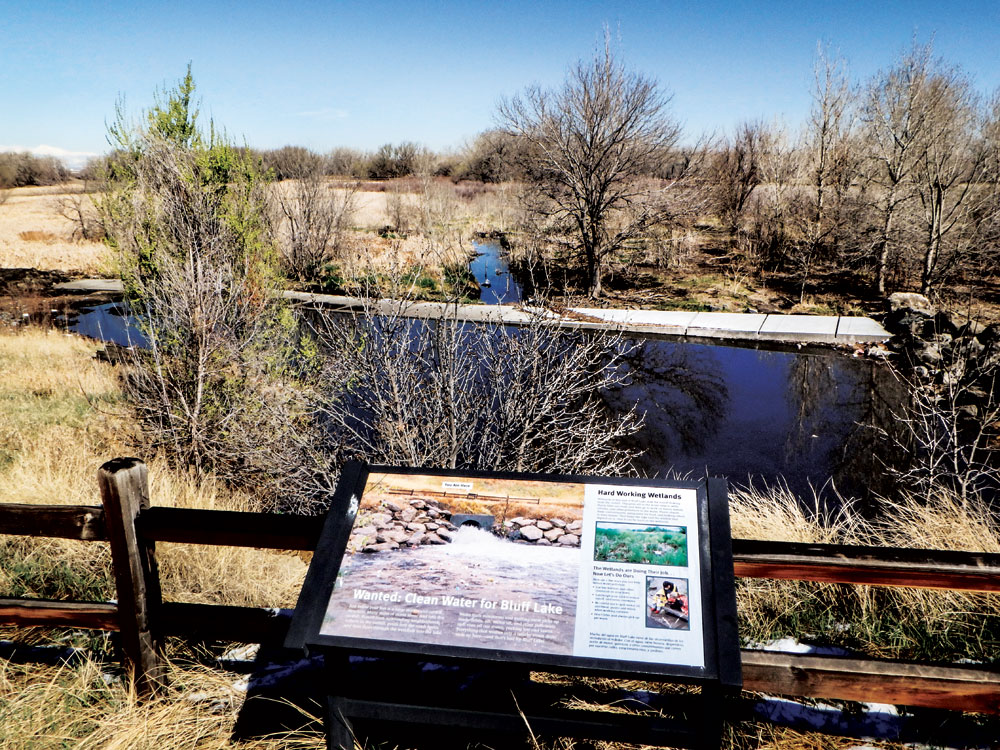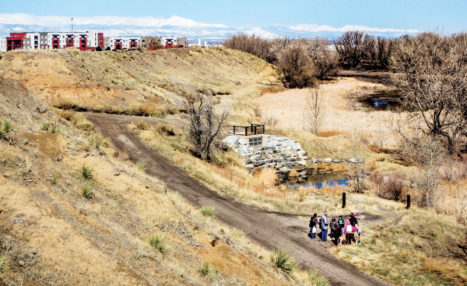
Apart from precipitation, all the water held by Bluff Lake arrives at two stormwater drainage “outfalls.” This is the original, eastern outfall. Photo by John Fernandez
Just as Bluff Lake was being improved to prevent leaks, the Bluff Lake Nature Center (BLNC) was informed by the state that they would have to drain the lake because the organization has no adjudicated rights to the water that flows into the pond from two storm drainage outfalls. Without such rights, these “waters of the state” must be pumped out and released to Sand Creek for consumption by downstream water rights holders.
Former BLNC Executive Director Jeff Lamontagne said neither he nor his board was aware of these facts when they informed the state last year of their plans to stabilize the dam face and seal the pond bottom. He said it appears 130-year-old Bluff Lake “flew under the radar” all these years, not drawing the attention of state regulators. The metaphor is apt because Bluff Lake was originally purchased by Stapleton Airport to serve as the crash zone for the east end of the airport’s runways.
The question now is how BLNC will be able to find enough water to maintain lake levels. One option currently under negotiation is for Bluff Lake to buy recycled water from Denver Water (a distribution line runs nearby). An engineer working for Bluff Lake, Joe Tom Wood, of Martin and Wood Water Consultants, has estimated they need to buy 30 acre-feet annually just to compensate for evaporation losses. (Maximum lake capacity is 45 acre-feet. One acre-foot equals approximately 326,000 gallons.)
Denver Water charges about $323 for one acre-foot. Bluff Lake says it has set aside a balance from its state grant to buy this water. However, other expenses and regulatory requirements stand in the way. In addition to a monthly service charge of $39.95, Denver Water will assess a one-time “system development charge” of $66,930 to tap into its system. And then there are questions such as who will apply for and pay for a discharge permit to allow the recycled water to flow into the lake, and whether the state will require additional treatment of the recycled water such as chlorine removal.

Storm drainage from Stapleton empties from this outfall into Bluff Lake, seen in its drained condition at upper right. Photo by John Fernandez
It is unknown how often the state will require BLNC to drain the water in the lake. BLNC would be entitled to retain whatever recycled water it purchases from Denver Water. It would also be able to keep “excess water” available when there has been no call by water rights holders. The problem, according to David Nettles, division engineer in the State Engineer’s office, is that the South Platte drainage in the metro area has been on continuous call since last summer. And with a dry winter on the plains, that call can be expected to continue indefinitely.
Historically, Bluff Lake has dried out each year by July or August. It has long been the Nature Center’s goal to stabilize lake levels not only to protect the natural resources there but also to enable it to conduct its outdoor education programs year-round.
Despite the challenges, BLNC board member Jeff Edson says he is “hopeful that the quality and quantity of Bluff Lake water will be a vast improvement even if there are calls for our water. It’s a really good thing that we have done. My hope is that we will still have a fairly large quantity of water in Bluff Lake year-round.”
In the meantime, the BLNC is being forced to join the ranks of water storers throughout Colorado who have to track the origins and amounts of water coming into their storage facility. Lake depth measurements and flow rates will be entered into a spreadsheet to document the amount of water they can keep and will need to release when made subject to a call on the river. And weekly or monthly, these records will be shared with the State Engineer’s office to demonstrate that Bluff Lake is playing by the rules necessary to ensure it is abiding by the state’s doctrine of prior appropriation (referred to colloquially as “first in time, first in right”).
The engineer who designed the recent lake improvements, Gene MacDonald of Ayres Associates, says he is evaluating an additional design feature—an open channel to capture the storm drainage before it enters the lake. That channel would be activated when the call on the river is made and would eliminate the pumping expense incurred under the existing conditions. Unresolved is whether that storm water drainage would have to be treated before being released directly to Sand Creek.
The $1.1 million grant to Bluff Lake came from the state’s settlement with the U.S. Army and Shell over damages to the state’s natural resources—and the grant money is earmarked for projects that restore natural resources. The irony is inescapable—the very state money being used to maintain year-round water levels at Bluff Lake has resulted in the state taking away the water intended to accomplish that goal.




0 Comments